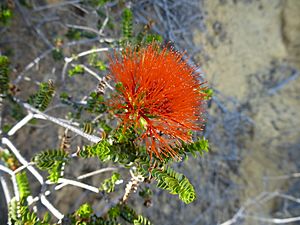Kalbarri beaufortia facts for kids
Quick facts for kids Kalbarri beaufortia |
|
|---|---|
 |
|
| B. aestiva (red form) | |
| Scientific classification | |
| Genus: |
Beaufortia (plant)
|
| Species: |
aestiva
|
| Synonyms | |
|
Melaleuca aestiva (K.J. Brooks) Craven & R.D.Edwards |
|
The Beaufortia aestiva, also known as Kalbarri beaufortia or summer flame, is a special plant. It belongs to the myrtle family, called Myrtaceae. This plant is only found in the south-west part of Western Australia. It's usually a thick, rounded bush with small leaves. In summer, it grows yellow or red flowers that look like bottlebrushes at the ends of its branches. It looks a bit like another plant called Beaufortia squarrosa, but that one is smaller and always has red flowers.
Contents
What the Kalbarri Beaufortia Looks Like
Beaufortia aestiva can be a thick, rounded shrub or a more open, spreading one. It usually grows to about 2 m (7 ft) tall and 2 m (7 ft) wide. Sometimes, it can even reach 4 m (10 ft) in height.
Its leaves are shaped like an egg, with the narrower end at the bottom. They are about 4–11 mm (0.2–0.4 in) long. The leaves grow in a special way: they are arranged in opposite pairs, turning slightly each time. This makes them form four neat rows along the stems.
The flowers can be creamy orange or red. They grow in round clusters, about 35–45 mm (1–2 in) across. These clusters are found at the ends of the branches. Even after the plant flowers, the branches keep growing. You can see these flowers from June to December, and sometimes even later. After the flowers, the plant produces woody fruits called capsules. These fruits are about 7–9 millimetres (0.3–0.4 in) long.
You can tell this plant apart from other beaufortias by its stamens. Stamens are the parts of the flower that produce pollen. In Beaufortia aestiva, the stamens are grouped in bundles of 5 to 7. They are quite long, about 28–40 mm (1–2 in), and are joined together for about half their length.
How the Kalbarri Beaufortia Got Its Name
The plant Beaufortia aestiva was officially described in 1998. This was done by a scientist named Kristine J. Brooks. She wrote about it in a scientific journal called Nuytsia. The plant she studied was found near a place called Binnu.
The second part of its scientific name, "aestiva," comes from a Latin word. It means "summer." This name was chosen because the plant flowers during the summer months.
Where the Kalbarri Beaufortia Lives
The Beaufortia aestiva mostly grows between Kalbarri and Eneabba. These areas are part of different natural regions in Western Australia, including the Avon Wheatbelt, Geraldton Sandplains, Jarrah Forest, and Yalgoo. It likes to grow in deep sand on flat areas called sandplains, in a type of shrubland known as kwongan.
Protecting the Kalbarri Beaufortia
The Western Australian Government's Department of Parks and Wildlife has looked at the Beaufortia aestiva. They have officially said that it is "not threatened." This means that there are enough of these plants in the wild, and they are not currently in danger of disappearing.
Other Flower Colors
-
Yellow form growing in Kalbarri National Park
-
Red and yellow form in Kings Park
Images for kids





